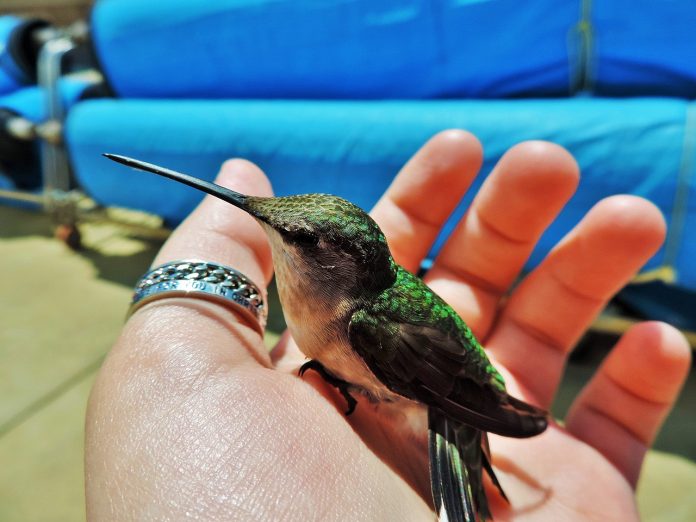In just a few weeks young hummingbirds will leave their nests, and females will introduce them to backyard nectar feeders. Nonstop action will ensue and entertain for as long as you care to watch.
To raise the bar a bit, try hand feeding hummers. With just a little patience, you can bring them to within inches of your face.
Hand-held feeder
Visit a nature center or wild bird store such as Wild Birds Unlimited and ask to see a hand-held nectar feeder. Or just go online and Google “hand-held nectar feeders.” Just browse through the hits to find something you like.
One that came on the market just a few years ago is called a “Red Nectar DOT.” At about an inch in diameter and three-quarters inch deep, it holds a small amount of nectar and retails for just a few dollars.
After hummers get in the habit of visiting your feeder, remove the feeder and replace it with a handheld DOT.
It’s best to sit while doing this because it may take the hummers some time to get the idea. Then sit back and enjoy the show as hummers take turns at the DOT.
Some may even perch on your hand. After the hummers begin using DOTS, invite friends, neighbors, children, and grandchildren to experience the thrill of hand feeding. Be sure to watch the expressions on their faces and take a few photos.
Buy a duck stamp
At $25, a “duck stamp” is arguably the best investment nature lovers, birders and conservationists can make.
More formally called the “Federal Migratory Bird Hunting and Conservation Stamp,” the duck stamp was created in 1934. Hunters lobbied to tax themselves to ensure that waterfowl would forever fill the skies.
A supplement to a state hunting license, a duck stamp is a federal license to hunt migratory waterfowl. Ninety-eight cents of every duck stamp dollar goes to the National Wildlife Refuge System to buy or lease wetland habitat.
Since 1934, duck stamps have raised more than $1 billion to protect and manage more than 5.7 million acres of wetlands.
And what’s good for ducks and geese is also good for common yellowthroats, marsh wrens, great blue herons, coots, ospreys, bald eagles, frogs, turtles, snakes, beavers, muskrats, mink, myriad fish, butterflies, dragonflies and other invertebrates.
In fact, the U.S. Fish & Wildlife Service estimates that one-third of the nation’s threatened species are found on National Wildlife Refuges.
Though duck hunters are required to buy a duck stamp every year, I recommend that every birder, wildlife watcher, hiker, and nature photographer buy one voluntarily to support wetland conservation.
Duck stamps also act as a pass to enter refuges that charge an admission fee. And each duck stamp is a miniature work of collectable art.
Furthermore, wetlands purify water supplies, store flood waters, reduce soil erosion and sedimentation, and provide spawning habitat for many fish.
The 2018-19 duck stamp by Minnesota artist Robert Hautman features a pair of mallards landing on the water.
The 2018-10 Junior Duck Stamp ($5) by Georgia teen Rayen Kang depicts an emperor goose. Proceeds from Junior Duck Stamps support conservation education programs, so they’re great for students, parents, and educators, as well as hunters and birders.
Duck stamps can be purchased at larger post offices, some outdoors stores, or online at www.duckstamp.com.
Water
Extreme heat like we’ve experienced in recent days requires extreme measures. When temperatures soar into the 90s, be sure to offer fresh water every day. Any shallow saucer or pan will do. Anchor it with a few flat rocks, and birds will visit every morning.
The appeal of fresh water is three-fold. First, birds drink it. Next, they bathe. And on very hot summer days, they linger and soak to lower their body temperature.
Watch carefully to observe pure avian joy.
Slingshot
Finally, here’s a tip from Pittsburgher John Bauman, who listens to my weekly radio show. He reports that brown thrashers in his backyard love in-shell peanuts.
I suspect they acquired the taste by watching blue jays. John offers peanuts to jays and thrashers by shooting them around the yard with a slingshot.













